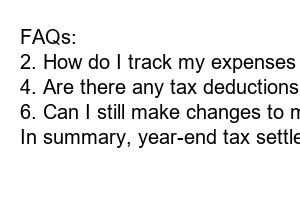연말정산 하는법
Title: Your Ultimate Guide to Year-End Tax Settlement Made Easy
Introduction:
As the year draws to a close, it’s time to prepare for year-end tax settlement. This important process ensures that you accurately report your income, deductions, and credits, ultimately determining your tax liability. In this blog post, we’ll guide you through the steps to make your year-end tax settlement a breeze, helping you avoid any potential pitfalls and maximize your tax deductions.
1. Gather and Organize All Relevant Documents:
To begin your year-end tax settlement, it’s crucial to gather all the necessary documents such as W-2s, 1099s, receipts, and bank statements. Organize them neatly to ensure a smooth process when preparing your tax return.
2. Review Important Changes in Tax Laws:
Stay updated with the latest changes in tax laws that may impact your year-end tax settlement. Familiarize yourself with adjustments made to deductions, tax rates, and credits to maximize your savings and minimize surprises come tax time.
3. Assess Your Income and Deductions:
Start by calculating your total income for the year, including wages, investments, and any other additional earnings. Then, evaluate your deductions carefully, ensuring you claim all eligible expenses such as mortgage interest, medical expenses, and charitable contributions.
4. Utilize Tax Credits:
Make sure to explore available tax credits, such as education, child tax credit, and energy-efficient home improvements. These credits can significantly reduce your tax liability, providing a valuable opportunity for savings.
5. Contribute to Retirement Accounts:
Consider maximizing your contributions to retirement accounts, such as 401(k) or IRA, before the year-end. These contributions can help lower your taxable income and generate long-term financial benefits.
6. Stay Organized with Estimated Payments:
If you are self-employed or anticipate owing taxes, ensure you have made the necessary estimated tax payments throughout the year. By doing so, you can avoid penalties and interest charges while maintaining a clear tax settlement record.
7. Seek Professional Assistance if Needed:
While navigating year-end tax settlement can seem daunting, don’t hesitate to seek professional assistance from a certified tax consultant. They can offer expert advice, answer any questions, and help you make informed decisions while optimizing your tax situation.
FAQs:
1. When is the deadline for year-end tax settlement?
2. How do I track my expenses efficiently for year-end tax settlement?
3. Can I deduct work-related expenses if I am self-employed?
4. Are there any tax deductions or credits specifically for homeowners?
5. What is the penalty for not paying estimated taxes throughout the year?
6. Can I still make changes to my tax return after year-end?
In summary, year-end tax settlement requires careful organization, assessment of income and deductions, and awareness of applicable tax laws. Utilizing tax credits, contributions to retirement accounts, and seeking professional assistance if needed can greatly optimize your tax situation. By following these steps, you can confidently tackle your year-end tax settlement and set yourself up for a successful financial future.

